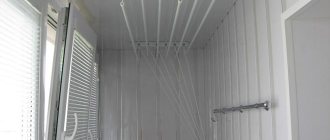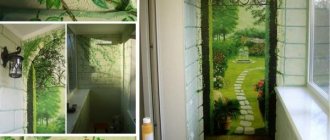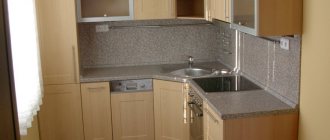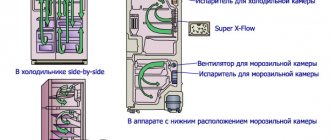Modern automatic washing machines allow you to get slightly damp laundry after washing, which does not need to take a long time to dry. However, many people prefer hand washing, especially for clothes made from thin, delicate fabrics that cannot be wringed too hard to avoid deformation. In this case, a clothes dryer on the balcony becomes a good assistant for housewives.
Clothes dryers come in different shapes and are suitable for both open and closed balconies.
The classic stretching of cords and ropes reduces the possibility of using the balcony space for other purposes: the stretched cords sag under the weight of the laundry and it takes up all the space.
Photo
Hanging Sliding
Outdoor
Wall-mounted
Ceiling
Folding
For a long time, housewives used two traditional methods of drying clothes: stretching cords and ropes and remote structures behind the balcony. Modern devices for laundry after washing have many variations, which will be discussed below.
Types of clothes dryers for the balcony
Return to content
Hanging
This combination of wall and floor fixture with drop-down panels is called the Liana. A hanging clothes dryer for a balcony is a structure attached to the ceiling, sometimes additionally fixed to the wall.
The dryer consists of several rods that can be moved vertically independently of each other.
In order to hang laundry, you only need to lower the bar down, then lift it up. A roller mount on the ceiling will cope with fixing the crossbar.
Photo gallery
The clothes dryer got its name because of its appearance and ease of use.
Return to content
Ceiling dryer
Among the ceiling models of balcony dryers, there are stationary and lowerable ones.
Stationary model: the linen cord is stretched between two metal trapezoids or wooden blocks attached to the ceiling.
Lowered model: a curtain rod for drying, the material can be aluminum, plastic or stainless steel, attached to the ceiling, then lowered to the required distance using a cord. After use, this structure is raised back.
This type of balcony dryer is very convenient, as it allows you to adapt to glazed balconies and not affect the window frames when they are opened, which makes it possible to ventilate the room.
Installation video:
Return to content
Sliding
Manufacturers now offer more modern devices: sliding hinged mechanisms that fold out in an “accordion” shape. The “ropes” in this design are crossbars made of wood, plastic or iron. After use, the sliding clothes dryer on the balcony moves and takes up little space. It has a beautiful shape.
Many housewives say that when drying things this way, there are no kinks, but a small amount of laundry can fit on the accordion, so for a large family it is best to choose a different dryer option.
Photo
Return to content
Folding
Folding clothes dryers for balconies can be either wall-mounted or floor-mounted.
The wall-mounted folding dryer consists of two parts, which are located at a certain distance from each other. There are cables between them; when folded, they are not visible. If necessary, the cables are stretched from one part and attached at the required distance to the second part.
After drying things, the cables are “hidden” back into one of the parts using the tape measure method.
The disadvantage of this design is the fact that the cables, if you dry heavy things on them, bend over time. Therefore, this type is intended more for drying light items.
Floor-standing folding dryers take up a little more space. They also unfold only when it is necessary to dry laundry. No additional effort is needed for fastening; just unfold the dryer and place things on it.
The advantage of this type is the presence of side “ears” and additional tiers, which allows you to dry as much laundry as possible.
Return to content
Outdoor
An outdoor dryer is the easiest to use on a balcony. Clotheslines are pulled onto fastenings located outside the balcony.
Suitable for those housewives who want things to dry in the open air and absorb the freshness of the air and sun, especially in winter, when clothes have a frosty aroma after drying outside.
Another advantage of this type: it takes up absolutely no space indoors.
There are also disadvantages to this model: difficulties in installing the mount depending on the balcony. If the balcony faces a busy side of the street, then things have the risk of exhaust gases getting on them, drying becomes unhygienic, and moreover, aesthetically unattractive.
Weather conditions also have a negative impact on drying clothes in this way:
- rain and snow can leave drop marks on white items;
- strong wind carries the danger that the laundry will simply fly down.
Return to content
Wall-mounted
It consists of two short side panels, which are connected to each other by a longer panel. It determines the length of the entire dryer. The design is U-shaped, with rods or ropes for hanging laundry between the side panels. Its length is not adjustable and is stationary.
Photo
Such dryers are located on the walls and practically do not attract attention. In addition to the function of a dryer, this device is a crossbar on which housewives place things that they often use.
Tips for choosing a design
When choosing a dryer design, you need to answer some questions:
- What items will require a dryer?
- Where should the dryer be located?
- What type of dryer should I use?
- Are there children in the family and how many members are there in the family?
- What material should the dryer be made of?
- Who made or in what country was the dryer made?
By answering these questions, it will be possible to choose a suitable model; of course, this will take a lot of time, but in the end you will be able to get a good, reliable design.
For example, if the laundry is small in size, then there is no need to build large structures from traverses with rods. It’s enough just to try installing clothes hangers on a balcony with a floor structure. But, if there is a need to hang bed linen or other large items, then you need to install long clothesline structures or suspended ceiling structures.
Also read: Balcony grilles: types, materials, manufacturing technologies
How can you stretch a clothesline on a balcony? First of all, you should find out the possibility of attachment points for the rope. If this is the outer part of the balcony, you should install brackets on which the ropes will be attached; for the inner area of the balcony you should also prepare either self-tapping hooks, or prepare two planks with such hooks and fix one on one side of the balcony, the other on the opposite side.
From the hooks on one side of the balcony, a linen cord is pulled to the other side and vice versa. This will create several parallel stretched clotheslines.
Wall and hanging dryers should also be installed on the wall, making holes and installing anchors. The fastenings must be very strong and reliable.
The materials of the best dryer designs are made of metal and covered with plastic. Stainless steel and aluminum designs are also good, but leave traces of oxidation. The best dryer manufacturers are German under the brand “Leifheit” and Italian models “Gimi”; Polish and Turkish models are good. Chinese dryers come under the Natalie or Delta brand. A good product cannot be cheap.
Design – Liana
If it is impossible to install the dryer on clothes lines, you should use a structure for clothes on the Liana balcony. This design is ceiling-mounted and provides good performance when drying clothes. Installing a Liana dryer solves the problem of drying large laundry and ensures good traffic in the area where the dryer is located.
Question: How to hang Liana on the balcony? First, you should determine the installation location of the structure on the ceiling, marking the places for installing anchors or dowels and carry out the installation, with preliminary perforation of the holes in the ceiling.
Then you should install the traverse blocks of the guide rods of the Liana ceiling dryer structure. And attach a cord retaining bar. It is necessary to install each rod using cords, passing them through sliding rollers on the traverses and securing them to the fixing bar.
Advantages of clothes dryers on the balcony
The main general advantages of clothes dryers on the balcony are saving space and avoiding humidity in the living room. The advantages of drying devices also depend on their specific type:
- Wall-mounted: compact and functional, easy to use, easy to install.
- Ceiling-mounted: withstand heavy loads, have a wide working area, are suitable for large-sized laundry, and free up space in the room as much as possible.
- Hanging: easy to install, easy to transport and adjust, can accommodate a large amount of laundry.
- External: they guarantee complete drying of things and a fresh smell, and do not take up any space on the balcony or loggia.
- Folding: compact, it is possible to adjust the length, conveniently folded when drying clothes.
- Sliding: the accordion can also be used folded; many housewives hang towels on it, which are often used in everyday life.
Return to content
Ceiling clothes dryers in the online store DOMDOM
Such a necessary product as ceiling clothes dryers will easily help you hang your laundry without taking up too much space in your apartment. In addition, if the laundry is poorly spun, it will not flow onto the floor, but into the bathroom, and excess water will not damage the floor covering. The highest quality materials are used for manufacturing, so for a low price you can purchase an excellent design that will serve you for many years. A huge selection of the DOMDOM online store will allow you to purchase a ceiling-mounted clothes dryer without leaving your home - you just need to choose the required model and we will deliver it to your home as soon as possible.
How to choose a clothes dryer for the balcony
When choosing a dryer for the balcony, you should pay attention to the following factors:
- Compactness. To ensure that laundry does not take up much space on the balcony, it is necessary to correlate the dimensions of the room with the dimensions of the potential dryer; to do this, first measure the length and width of the balcony and make markings.
- Material. When choosing dryers, you need to focus not only on the price, but also on the material from which they are made. Wooden fasteners must be coated with a protective varnish, and metal ones must have an anti-corrosion coating.
- Working surface. Indicates the maximum load of the device. If you have a large family, then you need to choose a model with a large working surface, designed not only for drying clothes, but also for heavy textiles.
- Balcony as a relaxation area. If the balcony is used as a relaxation room, it is best to purchase a ceiling model or an external type of dryer.
- Number of things. It is worth remembering that a wall-mounted dryer can accommodate a smaller amount of laundry after washing; the most capacity ones are: ceiling-mounted and “Liana”.
Return to content
Installation subtleties
Correct installation will save time, effort and nerves. Before starting installation, you should carefully study the instructions for the ceiling dryer for the balcony, photos and diagrams.
It is necessary to open the window completely - make sure that it will not touch the laundry.
Almost all designs have plastic fastenings. Therefore, for more reliable fastening, you should use not only dowels. But also small boards that need to be screwed to the wall or ceiling. If there are suspended or suspended ceilings on the balcony, then the dryer will have to be installed in another room. Or use an embedded beam - there will be a ceiling dryer on it. To reduce the likelihood of damage to the canvas, you need to stick small pieces of tape in the places where the holes are supposed to be.
It is not recommended to install structures on unglazed balconies and loggias. Because in winter the laundry will freeze.
If the floors are wooden, then a drill will be enough for installation work. Otherwise, you need to use a hammer drill and drills (6 mm, 8 mm). You will also need a tape measure and a screwdriver.
Almost all dryers have plastic mounts
The ceiling brackets on which the entire structure is supported must first be attached to the ceiling and the drilling locations must be marked. Then make as many holes as possible, since wet things place a significant load on the entire structure. Secure the dowels.
Markings are made on the wall for fixing brackets. It is not advisable to place it in hard-to-reach places. The placement height depends on the design features. The optimal distance from the floor is 1.5 m.
It is also necessary to accurately calculate the spaces between strings and ropes. It is better if the distance is about 10 cm. This will be enough for free air circulation. This will allow the laundry to dry faster.
Assembling the structure is quite simple. The kit comes with two types of cords:
- long ones are passed through roller brackets;
- short ones are attached to a fixing bracket.
The cords are alternately passed through the upper and lower rod. This allows for reliable fixation.
If the dryer is made of stainless steel, you don’t have to wipe it after wet laundry.
After installation is completed, it is necessary to lower all the tubes, hang the maximum amount of clothing, and raise the structure. If nothing creaks or falls off, the installation work was completed successfully.
If the dryer is made of stainless steel, you don’t have to wipe it after wet laundry. It is better to dry plastic dryers thoroughly as they are not very durable and require maintenance.
During operation, it is necessary to check the condition of the ropes from time to time. High-quality dryers have durable threads that can last up to 10 years. But constant rubbing and contact with sharp objects can significantly reduce the service life.
Installing a clothes dryer on the balcony
Before installing the dryer, you need to open the balcony frames (when the balcony is glazed) and determine the location of the fastening. It is necessary to take into account additional nuances during installation; you may need special planks, screws, dowels or anchor bolts that will allow you to fix the dryer more firmly.
You can install the structure yourself. In the instructions for the devices, all actions are described step by step, some even have photographs of the installation process. On the Internet you can find video tutorials on installing each type of dryer.
The distance from the device to the floor and walls should be taken into account. It should be placed at a height that is convenient for hanging laundry (the exception is ceiling-mounted ones - they are adjustable).
If the balcony is actively used as part of the living space, then the height of the dryers should correspond to the height of the tallest member of the family.
When stretching laundry cords or ropes, you need to remember that the distance between them should be at least 10 centimeters - this will ensure better air circulation and maximum drying of things.
But if there are problems with the installation, and you are not sure that you can cope with this task yourself, then it is better to invite a specialist. It will be able to firmly secure the dryer and prevent negative consequences from improper installation.
Return to content
Types of dryers
All types of dryers for laundry are suitable for balconies and loggias, with the exception of outdoor stationary modifications:
- external - the linen does not obscure the window opening, but spoils the appearance of the building’s facade;
Brackets with several rows of rope for outdoor use - internal - have many more design options.
Options for indoor clothes dryers.
The dimensions of the balcony in apartments of different standard house designs are not the same. Some of them can accommodate multiple internal dryers. For absolutely all loggias/balconies, the option of using both external and internal structures for drying clothes is applicable.
Most ceiling and wall structures, including sliding ones, are incompatible with hinged glazing frames for balconies and loggias. Hanging laundry interferes with the opening of the doors; you should pay attention to this before choosing.
The main advantages of internal dryers are:
- no clothespins or other devices are needed to secure washed items in gusts of wind;
- operation in any weather conditions, precipitation does not fall on the glazed area;
- convenient roller or folding system for lowering lines during hanging, lifting for drying.
Ceiling
The main types of ceiling structures for hanging things damp from a washing machine are:
- “Liana” - manual rope lifting mechanism, ceiling slats with rollers, 4 - 6 tubular lines made of polymer material or metal (aluminum, steel), load capacity 1.5 - 2.3 kg for each row from different manufacturers;
"Liana." “Accordion” – manual drive, scissor-type rack and pinion sliding mechanism, 4 lines with a load capacity of 2 kg each;
Ceiling accordion. electric “accordion” – controlled from a remote control, has a fan, sliding tubes, a UV emitter for disinfecting things, an electric lifting and lowering mechanism with protection from obstacles.
Electric accordion. frame structure is similar to Liana, but all lines are fixed to a common frame, rise and fall simultaneously, and not separately;
Frame design. dryer with hangers - ceiling mounting of guides along which clothes hangers move, not suitable for bed linen;
Option with clothes hangers. “Chandelier” is a round rim with clothespins, used as an additional hanging structure for drying small items (gloves, socks, scarves, caps).
“Chandelier”
Frame structures can be large, occupying more than 2/3 of the perimeter of the balcony. Or they are small in size so as not to interfere with the opening of the swing windows of the loggia. In the latter case, the lines can be located both longitudinally relative to the long wall of the room, and transversely.
There are two-tier frame structures, the lower level of which is used as usual, and items made of delicate fabrics are laid out on the upper shelf.
Two-level design for drying regular and delicate fabrics.
It is very rare to find articulated ceiling structures in stores.
The main difference between these modifications is fixation in the lower position without the help of wall-mounted cord hooking, greater load capacity and spatial strength.
For clothes made of delicate fabrics that cannot be hung but must be dried folded, the industry produces hanging mesh baskets.
Wall mounted
In the category of wall-mounted dryers, there is a conditional classification according to the following criteria:
- fastening - on one wall or between two opposite walls (this option is suitable exclusively for a loggia);
- the presence of transformation mechanisms - stationary, folding, sliding, folding;
- sizes – large-sized, medium-sized, small-format.
Only for loggias is a tension string type of wall dryer used.
The tension dryer is brought into working position only when hanging clothes, so it has a compact appearance.
For most manufacturers, Liana is a universal type dryer. The kit includes both ceiling and wall brackets.
Wall "Liana".
The sliding model of a wall-mounted dryer for a loggia (pictured below) is almost invisible when folded.
Folding structures are very diverse, for example:
- Telegant 100 from Leifheit - side brackets tilt to the side or fold against the wall, eight strings 0.9 m long are designed for a standard washing machine load of 4.5 kg;
Telegant 100 Teleclip from the same manufacturer - accordion sliding mechanism, length 0.6 m or 1 m, total line length 4.2 m or 7.4 m, respectively;
Teleclip Wallfix manufactured by Brabantia - folding umbrella mechanism, dimensions 14x15.5x108 cm and 105x180x182 cm in the burned and unfolded state, respectively, load capacity 40 kg, string length 24 m;
Wallfix In the folding versions of wall-mounted clothes dryers, the idea of a lower support moving along a guide profile is implemented.
Folding frame with lower supports
- Frame with top fixation by rods. This design is easy to make with your own hands.
- Less commonly, the frame is held in a vertical/horizontal position by a special mechanism inside a slot in the mounting brackets.
An original version of a wall-mounted folding dryer.
Transformable models are convenient for swing doors of balcony glazing. While drying things, the interior space of the room is occupied, the windows do not open. When folded, there is no linen on the lines; the transoms open for ventilation. With sliding window sashes this does not matter much.
External
In most apartments built during the USSR, balconies do not have a parapet as such. Instead, a steel strip structure covered with flat slate was used. On such balconies, the only option for an external clothes dryer is welded “horns” from a corner or profile pipe. They are usually installed at the glazing stage.
If there is a parapet, brackets with several rows of linen cord attached to rollers are used.
The second place in the rating of external dryers for loggias is occupied by the “accordion” with upper metal arches.
Arcs 60–80 cm in length are often installed outside the window, even in the absence of a balcony. The last option for an external dryer for washed clothes on a loggia/balcony is a wall-mounted plastic model.
Its functionality is limited, since the hook can only hook onto railings or protruding parts of the parapet. If there is a window sill inside, installation is not possible. But on loggias without glazing, such a structure can be deployed both inward and outward, depending on weather conditions.
How to make a clothes dryer with your own hands
You can also make a clothes dryer at home, this will reduce financial costs and give you the opportunity to be creative in its creation.
For a ceiling dryer, there are several steps you need to follow: create the dryer, fix it to the ceiling, and then stretch the ropes.
Algorithm for creating a simple ceiling dryer
- Purchase the parts: two wooden blocks - used as fastenings (their size depends on the width of the ceiling on the balcony and the preferences of the owners), 10 self-tapping rings, a linen cord.
- Prepare a drill, hammer drill and dowels - necessary for fastening.
- Drill 5 holes on each block so that they are symmetrically located. Carefully clean the holes and screw the screws into them. The drill should have a smaller diameter than the diameter of the screws: this will ensure a tight fit in the holes. As a result, the self-tapping rings should hang towards the floor.
- On the ceiling, drill three holes for each fastening and using dowels (or better yet, metal expansion anchors, since wet clothes have a lot of weight, and they provide a stronger fixation) attach the strips to the ceiling. The balcony is a place of high humidity, so cover the planks with varnish that will protect them from swelling and drying out.
- After the varnish has dried, tighten the clothesline. The dryer is ready!
Return to content











